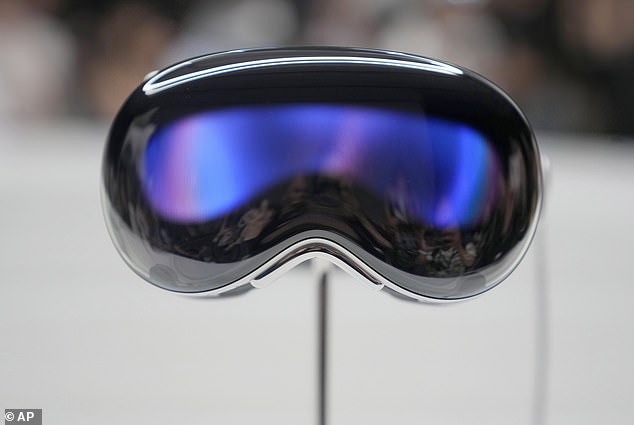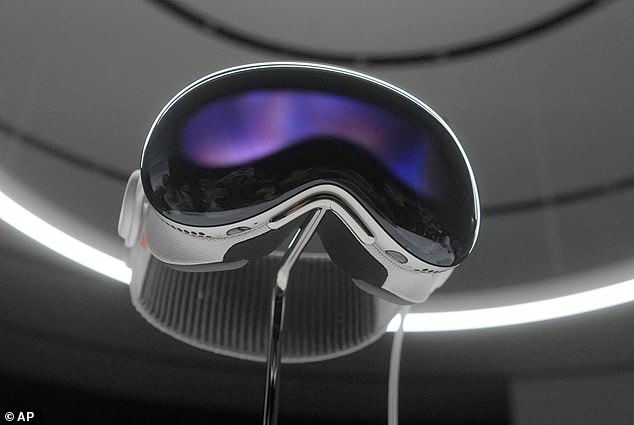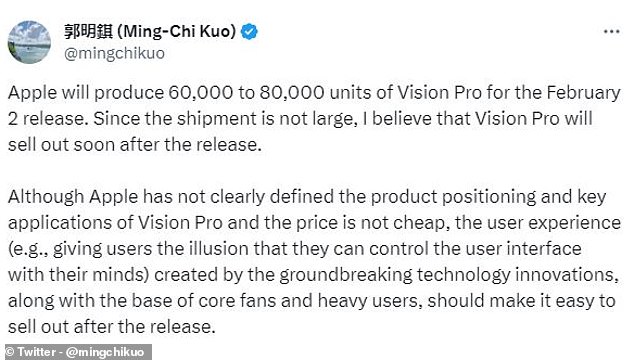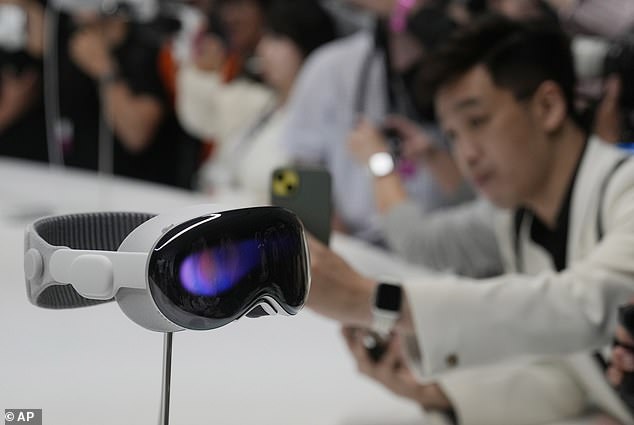Apple’s long-awaited Vision Pro headset with a price tag of $3,499 is finally getting a release date
Apple has finally revealed the release date for Vision Pro, the headset that lets wearers choose apps with their eyes.
The tech giant will start shipping the high-end gadget in the United States on February 2, with pre-orders starting January 19 at 8am EST.
However, the company hasn’t confirmed when it will be available internationally, so UK Apple fans will have to wait.
At $3,499 (£2,749), Vision Pro is more than five times as expensive as the rival Meta Quest 3.
Carriers will also face additional costs, as Apple reveals that prescription inserts will cost an extra $149 (£117).
Apple has finally announced the release date for its highly anticipated Vision Pro augmented reality headset, which will start shipping on February 2

Pre-orders for the headset will be available in the US from January 19, but there’s no confirmation on when the Vision Pro will be available overseas
The base model of the virtual and augmented reality headset comes with 256GB of storage and comes with a number of accessories.
These include a ‘Solo Kit Band and Dual Loop Band’, a light seal and two light seal cushions, an Apple Vision Pro cover, chargers and power adapters, and a battery.
Those wishing to purchase Zeiss magnetic corrective lenses must also order online rather than in a store and need a valid prescription.
However, the ordering process can be a lot more complicated than with previous Apple products.
In an email sent to Apple customers ahead of the release, the company explained that customers will need to have an iPhone or iPad ready to scan their face in order to order.
The email said: ‘If you order Apple Vision Pro, you will need to scan your face with an iPhone or iPad with Face ID.
‘This helps us determine the correct size Light Seal and headbands, which work together to give you a precise fit.’

The Vision Pro was first unveiled in June at WWDC, pictured here, where it was touted as the most advanced consumer electronics device ever

The Vision Pro allows users to interact with apps and Apple devices using their eyes, hands, head and voice
Veteran Apple analyst Ming-Chi Kuo also warns that the Vision Pro will likely sell out shortly after launch.
In a post on
“Since the shipment is not large, I think Vision Pro will sell out soon after release.”
Apple CEO Tim Cook says the headset is the “most advanced consumer electronics device ever created.”

Apple analyst Ming-Chi Kuo predicted on X that the headset would sell out soon after release

However, the device must be connected to the wall socket or to the battery; there is no standalone use
Cook adds, “The age of spatial computing has arrived. The revolutionary and magical user interface will redefine the way we connect, create and discover.”
Apple first unveiled the Vision Pro during the World Wide Developers Conference (WWDC) in June last year.
By combining an augmented reality and virtual reality headset, Apple claims that the Vision Pro is able to combine digital content with the physical world.
By wearing the headset, users can overlay elements of their Apple devices onto the real world.
Using head, eye and hand tracking, the Vision Pro allows users to interact with more than a million compatible apps without the need for a controller.
Instead, users can select content with their eyes, scroll by swiping, and click by tapping their fingers together.

The Vision Pro runs on Apple’s new Vision OS operating system, which they describe as the first ever spatial operating system
With a 4K display in each eye, users can also enjoy movies and games in super high definition on screens that feel ’30 feet wide’.
For more immersion, owners can use a dial on the headset to switch from augmented reality (which overlays the screen over the real world) to virtual reality.
This gives users more ways to interact with familiar apps like FaceTime and Photos, as well as the ability to watch spatial videos shot with the iPhone 15 Pro.
Apple says the Vision Pro’s EyeSight feature will allow people in the room to know whether users are in virtual or augmented reality.
The screen shows people in the room the user’s eyes when they are in augmented reality and goes dark when they are immersed in a virtual world.

The EyeSight feature lets people in the room see the user’s eyes when they are in augmented reality and turns opaque, as shown here, when immersed in virtual reality
The headset runs on Vision OS, which Apple calls “the world’s first spatial operating system.”
This is made possible by a dual-chip operating system, which uses Apple’s M2 chip and a new R1 chip.
The R1 is specifically intended for processing data from the headset’s cameras, sensors and microphones.
The headset has a battery life of two hours and can only operate when connected to a separate battery or external power source.
There’s no standalone mode, as Apple has removed the power sources from the headset itself to save weight.
